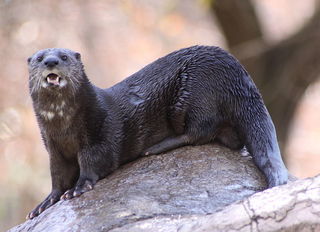
Original source: Flickr: Spotted necked otter
Author: derekkeats
Spotted-necked otter
Order : Carnivora
Family : Mustelidae
Subfamily : Lutrinae
Species : Lutra maculicollis
The Speckle-throated otter, spot-necked otter, spotted-necked otter is listed as Least Concern. Does not qualify for a more at risk category. Widespread and abundant taxa are included in this category, on the IUCN Red List of Threatened Species
Namings for the spottednecked otter
A young / baby of a spottednecked otter is called a 'pup or whelp'. A spottednecked otter group is called a 'romp, bevy, lodge, family or raft'.Countries
Angola, Benin, Botswana, Burkina Faso, Burundi, Cameroon, Central African Republic, Chad, Congo, Democratic Republic of the, Congo, Republic of the, Cote d'Ivoire, Egypt, Equatorial Guinea, Eritrea, Ethiopia, Gabon, Ghana, Guinea, GuineaBissau, Kenya, Lesotho, Liberia, Malawi, Mali, Mozambique, Namibia, Niger, Nigeria, Rwanda, Sierra Leone, South Africa, Sudan, Tanzania, Togo, Uganda, Zambia and ZimbabweSpotted-necked otter habitats
Artificial / Aquatic & Marine, Artificial / Aquatic - Aquaculture Ponds, Artificial / Aquatic - Canals and Drainage Channels, Ditches, Artificial / Aquatic - Ponds (below 8ha), Artificial / Aquatic - Water Storage Areas (over 8ha), Artificial / Terrestrial, Bogs, Marshes, Swamps, Fens, Peatlands, Coastal Brackish / Saline Lagoons / Marine Lakes, Coastal Freshwater Lakes, Forest, Freshwater Springs and Oases, Grassland, Marine Coastal / Supratidal, Pastureland, Permanent Freshwater Lakes (over 8ha), Permanent Freshwater Marshes / Pools (under 8ha), Permanent Inland Deltas, Permanent Rivers / Streams / Creeks (includes waterfalls), Permanent Saline, Brackish or Alkaline Lakes, Permanent Saline, Brackish or Alkaline Marshes / Pools, Seasonal / Intermittent Freshwater Lakes (over 8ha), Seasonal / Intermittent Freshwater Marshes / Pools (under 8ha), Seasonal / Intermittent Saline, Brackish or Alkaline Lakes and Flats, Seasonal / Intermittent Saline, Brackish or Alkaline Marshes / Pools, Seasonal / Intermittent / Irregular Rivers / Streams / Creeks, Shrub Dominated Wetlands, Shrubland, Subtropical / Tropical Mangrove Vegetation Above High Tide Level, Subtropical / Tropical Moist Lowland, Subtropical / Tropical Moist Shrubland, Subtropical / Tropical Seasonally Wet / Flooded Grassland, Subtropical / Tropical Swamp and Wetlands (inland)
Facts about the spotted-necked otter
The spot-necked otter (Lutra maculicollis) is also known from the wetlands of this ecoregion, as is the banded mongoose (Mungos mungo), white tailed mongoose (Ichneuma albicauda) and the bushy tailed mongoose (Bdeogale crassicauda). (Full text)
The spotted-necked otter Lutra maculicollis is smaller, with a combined head and body length of about 600mm and it weighs only 4 to 5 kg.
The Spotted-Necked Otter is one of the most proficient swimmers of all freshwater otters. (Full text)
Social Behavior The spotted-necked otter is typically solitary.
So the earliest name has been restored, and the Spotted-Necked Otter is once more Lutra maculicollis.
The spotted-necked otter is thought to breed seasonally, but the actual season seems to vary throughout the range between September and December.
The Spotted-Necked otter is one of the most proficient swimmers of all freshwater otters.
Lutra maculicollis (spotted-necked otter) is found in central Africa south of 10 degrees N latitude. (Full text)
The spotted-necked otter is typically solitary. (Full text)
The Spotted-necked Otter is fairly common but the other two species are rare.
The spotted necked otter is smaller and darker than the Cape clawless otter
The spotted-necked otter is a playful, aquatic animal found in lakes, rivers, and swamps of central and southern Africa.
Spotted-necked otters are some of the most proficient swimmers.
Protection from Predators: since spotted-necked otters are preyed on by eagles and crocodiles, perhaps a pack offers protection ( Kruuk (1995)).
Sport Fishing In affluent and tourist areas, spotted-necked otters are regarded as competitors for sport fish and persecuted accordingly, although the animals are too uncommon to really affect fish stocks for good or bad.
Although spotted-necked otters are not endangered, this species is considered vulnerable due to hunting, wetland loss, fishing
Giant monitor lizards and spotted-necked otters are often seen on the rocks around the island.
Playful spotted necked otters are commonly seen performing in the Lagoon right in front of the tents.
More animals beginning with S
